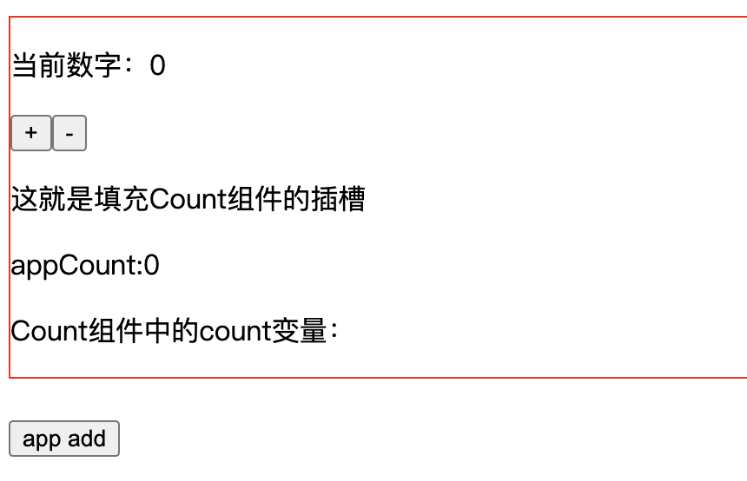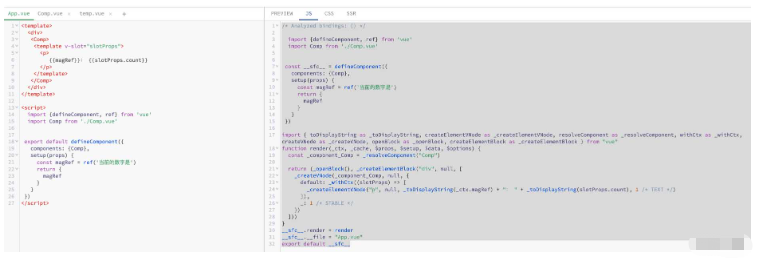这篇文章主要介绍了Vue中的slot如何使用的相关知识,内容详细易懂,操作简单快捷,具有一定借鉴价值,相信大家阅读完这篇Vue中的slot如何使用文章都会有所收获,下面我们一起来看看吧。在Vue中,我们使用组件来组织页面和组织代码,类似于搭
这篇文章主要介绍了Vue中的slot如何使用的相关知识,内容详细易懂,操作简单快捷,具有一定借鉴价值,相信大家阅读完这篇Vue中的slot如何使用文章都会有所收获,下面我们一起来看看吧。
在Vue中,我们使用组件来组织页面和组织代码,类似于搭积木,每一个组件都是一个积木,使用一些相同或者不同组件就能搭建出我们想要的页面。
slot(插槽)是组件功能的重要组成部分,插槽必须用于组件才有意义。
它为组件提供了对外的接口,允许从组件外部传递内容,并将这部分内容放置到指定的位置。
当一个组件可能被使用至少两次并且两次使用内容(这里指组件视图的组成)不同时,插槽才有存在的必要。注意: 本文的代码都是基于vue3编写。
Link.vue
<template> <a :href="href" rel="external nofollow" class="link"> <!-- 留个插槽,外界传入内容放置在这里 --> <slot></slot> </a></template><script>export default { props: { href: { required: true, type: String, }, },};</script><style lang="less" scoped>.link { display: inline-block; line-height: 1; white-space: nowrap; cursor: pointer; background: #fff; border: 1px solid #dcdfe6; color: #606266; -WEBkit-appearance: none; text-align: center; box-sizing: border-box; outline: none; margin: 0; transition: 0.1s; font-weight: 500; padding: 12px 20px; font-size: 14px; border-radius: 4px;}</style>App.vue
<template> <div class="app"> <Link href="https://baidu.com" rel="external nofollow" > 百度</Link> <br /> <Link href="Https://Google.com" rel="external nofollow" > <!-- 这里允许放置任意的内容,包括字符串和标签 --> <span>Icon</span>谷歌</Link > </div></template><script>import Link from "./Link.vue";export default { components: { Link, },};</script>视觉效果:

以上实现了两个组件Link.vue和App.vue,Link.vue是一个链接组件,在组件内部已经定义好了样式,然后链接的内容交由外界使用时填充。
在App.vue组件内则使用了Link.vue组件两次,并且两次传入的内容不同。
上面的Link.vue只要求填充一份内容,那么当我们需要在组件的好几个位置都填充不同的内容应该怎么办?这时候可以使用具名插槽,就是给组件的每个填充区域都取个名字,这样在使用的时候就可以往对应名字的那个区域填充内容。
Page.vue
<template> <div class="page"> <header class="page-header"> <slot name="header"></slot> </header> <div class="page-center"> <aside class="page-aside"> <slot name="aside"></slot> </aside> <div class="page-content"> <slot name="content"></slot> </div> </div> <footer class="page-footer"> <slot name="footer"></slot> </footer> </div></template><script>export default { setup() { return {}; },};</script><style lang="less">body { margin: 0;}.page { border: 1px solid #333; width: 100vw; height: 100vh; display: flex; flex-direction: column; &-header { height: 50px; border-bottom: 1px solid #333333; } &-center { flex: 1; display: flex; } &-aside { width: 150px; border-right: 1px solid #333333; } &-content { flex: 1; } &-footer { border-top: 1px solid #333; height: 30px; }}</style>App.vue
<template> <Page > <template v-slot:header>这是标题</template> <template v-slot:aside>这是侧边栏</template> <template v-slot:content>这是内容区域</template> <template v-slot:footer>这是页脚</template> </Page> <Page > <template v-slot:header> <h3>走过路过</h3> </template> <template v-slot:aside> <ul> <li>东临碣石</li> <li>以观沧海</li> </ul> </template> <template v-slot:content>这是内容区域</template> <template v-slot:footer>这是页脚</template> </Page></template><script>import Page from "./Page.vue";export default { components: { Page, },};</script>效果图:

为啥叫作用域插槽?首先要搞清楚作用域这个概念。在js中,作用域表示的是当前的执行上下文,只有在当前作用域中变量才可以被使用。作用域有层次之分,分为父作用域和子作用域,子作用域可以访问父作用域中的变量,这一层层的往上则形成了作用域链。JS中只有全局作用域和函数作用域,es6新增了块级作用域。关于作用域,这里不再赘言,有需要的同学可以去MDN作用域查看。
Vue本质上还是js,模板最终会被编译成render函数,每个组件都有一个render函数。下面先看个例子:
Count.vue
<template> <div> <p>当前数字:{{ count }}</p> <button @click="onAdd">+</button> <button @click="onMinus">-</button> <slot></slot> </div></template><script>export default { data() { return { count: 0, }; }, methods: { onAdd() { this.count++; }, onMinus() { this.count--; }, },};</script>App.vue
<template> <div> <Count > <p>这就是填充Count组件的插槽</p> <p>appCount:{{ appCount }}</p> <p>Count组件中的count变量:{{ count }}</p> </Count> <br /> <button @click="onClick">app add</button> </div></template><script>import Count from "./Count.vue";export default { components: { Count, }, data() { return { appCount: 0, }; }, methods: { onClick() { this.appCount++; }, },};</script>效果图:

从上面的效果图中可以看到,在App.vue组件中使用Count.vue组件时,在Count.vue组件的插槽中,能够访问appCount变量,但是不能访问Count.vue组件的Count变量,这是为什么呢?理论上,插槽传入的内容最终会插入到Count.vue组件中,那么也应该可以访问Count.vue组件的变量才对啊?
父级模板里的所有内容都是在父级作用域中编译的;子模板里的所有内容都是在子作用域中编译的。
上面的一段引用摘自Vue文档,这段文字表明了,在App.vue中的一切,包括Count.vue组件的插槽内容都是在App.vue组件下编译的,也就是Count.vue组件的插槽模板可以访问App.vue组件的所有变量,但不能访问Count.vue的任意变量。如果我一定要在插槽中访问Count.vue的count变量呢?这个时候作用域插槽就派上用场了。
作用域插槽允许在组件中对插槽所在的上下文暴露某一些变量,改写以上的Count.vue组件,
Count.vue
<template> <div> <p>当前数字:{{ count }}</p> <button @click="onAdd">+</button> <button @click="onMinus">-</button> <!-- 把count变量暴露到插槽作用域 --> <slot :count="count"></slot> </div></template><script>export default { data() { return { count: 0, }; }, methods: { onAdd() { this.count++; }, onMinus() { this.count--; }, },};</script>App.vue
<template> <div> <Count > <!--Count组件插槽暴露的所有变量都放在 slotProps对象中 --> <template v-slot="slotProps"> <p>这就是填充Count组件的插槽</p> <p>appCount:{{ appCount }}</p> <p>Count组件中的count变量:{{ slotProps.count }}</p> </template> </Count> <br /> <button @click="onClick">app add</button> </div></template><script>import Count from "./Count.vue";export default { components: { Count, }, data() { return { appCount: 0, }; }, methods: { onClick() { this.appCount++; }, },};</script>这就是作用域插槽,本质上了是允许在父组件作用域访问到子组件作用域,它为插槽模板区域提供了一个数据来源于子组件的上下文。
作用域插槽的用处还是挺广的,总的来说当你需要它时自然会用到它,如果想提前学习,可以看一下elementUI的table组件。
上面就插槽的使用说了一大堆,关于插槽的实现还是没有涉及,下文讲解在Vue中插槽是如何实现的?
首先,我们都知道,无论是使用jsx还是模板,最终都会编译成render函数,并且render函数在执行之后会输出 Virtual Dom ,下面先看一个组件在编译完成之后是什么样子?
Comp.vue
<template> <div> <p>count: {{count}}</p> <button @click="onClick"> ADD </button> <slot :count="count"></slot> </div></template><script> import {defineComponent, ref} from 'vue' export default defineComponent((props) => { const count = ref(0); const onClick = () => { count.value++ } return { count, onClick } }) </script>App.vue
<template> <div> <Comp> <template v-slot="slotProps"> <p> {{magRef}}: {{slotProps.count}} </p> </template> </Comp> </div></template><script> import {defineComponent, ref} from 'vue' import Comp from './Comp.vue' export default defineComponent({ components: {Comp}, setup(props) { const magRef = ref('当前的数字是') return { magRef } } }) </script>Comp.vue编译之后:
import { defineComponent, ref} from 'vue'const __sfc__ = defineComponent((props) => { const count = ref(0); const onClick = () => { count.value++ } return { count, onClick }})import { toDisplayString as _toDisplayString, createElementVnode as _createElementVNode, renderSlot as _renderSlot, openBlock as _openBlock, createElementBlock as _createElementBlock} from "vue"function render(_ctx, _cache, $props, $setup, $data, $options) { return (_openBlock(), _createElementBlock("div", null, [ _createElementVNode("p", null, "count: " + _toDisplayString(_ctx.count), 1 ), _createElementVNode("button", { onClick: _cache[0] || (_cache[0] = (...args) => (_ctx.onClick && _ctx.onClick(...args))) }, " ADD "), _renderSlot(_ctx.$slots, "default", { count: _ctx.count }) ]))}__sfc__.render = render__sfc__.__file = "Comp.vue"export default __sfc__App.vue编译之后:
import { defineComponent, ref} from 'vue'import Comp from './Comp.vue'const __sfc__ = defineComponent({ components: { Comp }, setup(props) { const magRef = ref('当前的数字是') return { magRef } }})import { toDisplayString as _toDisplayString, createElementVNode as _createElementVNode, resolveComponent as _resolveComponent, withCtx as _withCtx, createVNode as _createVNode, openBlock as _openBlock, createElementBlock as _createElementBlock} from "vue"function render(_ctx, _cache, $props, $setup, $data, $options) { const _component_Comp = _resolveComponent("Comp") return (_openBlock(), _createElementBlock("div", null, [ _createVNode(_component_Comp, null, { default: _withCtx((slotProps) => [ _createElementVNode("p", null, _toDisplayString(_ctx.magRef) + ": " + _toDisplayString(slotProps.count), 1 ) ]), _: 1 }) ]))}__sfc__.render = render__sfc__.__file = "App.vue"export default __sfc__
这个编译是在加载.vue文件的时候就执行了,runtime阶段是不存在模板字符串了(使用UMD的时候会存在),在浏览器中执行的都是编译之后的js。下面具体分析一下以上Comp.vue和App.vue编译之后的js代码。
首先在Comp.vue中,<slot :count="count"></slot>会被编译成_renderSlot(_ctx.$slots, "default", {count: _ctx.count}),下面看看_renderSlot中干了什么?
export type Slot = (...args: any[]) => VNode[]export type InternalSlots = { [name: string]: Slot | undefined}export function renderSlot( slots: Slots, name: string, props: Data = {}, // this is not a user-facing function, so the fallback is always generated by // the compiler and guaranteed to be a function returning an array fallback?: () => VNodeArrayChildren, noSlotted?: boolean): VNode { let slot = slots[name] openBlock() const validSlotContent = slot && ensureValidVNode(slot(props)) const rendered = createBlock( Fragment, { key: props.key || `_${name}` }, validSlotContent || (fallback ? fallback() : []), validSlotContent && (slots as RawSlots)._ === SlotFlags.STABLE ? PatchFlags.STABLE_FRAGMENT : PatchFlags.BAIL ) return rendered}_renderSlot(_ctx.$slots, "default", {count: _ctx.count})这一句显然是执行_ctx.$slots.default({count: _ctx.count}),这说明在父组件中,每个插槽模板最终会被编译成一个函数,并且这个函数会被传递到子组件,在子组件里面会以props(这里是{count: _ctx.count})作为参数执行插槽函数,最终_ctx.$slots.default({count: _ctx.count})会返回virtual dom对象。
下面再看一下App.vue组件:
<Comp> <template v-slot="slotProps"> <p> {{magRef}}: {{slotProps.count}} </p> </template> </Comp>被编译成了:
_createVNode(_component_Comp, null, { default: _withCtx((slotProps) => [ _createElementVNode("p", null, _toDisplayString(_ctx.magRef) + ": " + _toDisplayString(slotProps.count), 1 ) ]), _: 1 })请忽略_withCtx,显然模板会编译成一个函数,并传递到子组件,进而在子组件中构建出完整的virtual dom, 上面中_ctx是当前组件的上下文,slotProps则是作用域插槽暴露的参数。
由此可以做一个总结,vue slot的实现原理:
所有的模板会被编译成创建vnode的函数。
父组件中传递给子组件的插槽(每个插槽都是一个函数,即名字不同的插槽为不同的函数)内容模板也会被编译成函数并且传递给子组件,模板中如果使用了父组件的变量,那么会通过闭包的形式在插槽函数中被使用。
子组件在接收到父组件传递的插槽内容函数,会以在slot暴露的变量(只有作用域插槽有这些变量)为参数执行这个函数,返回vnode,这个vnode会作为子组件vnode的一部分。
关于“Vue中的slot如何使用”这篇文章的内容就介绍到这里,感谢各位的阅读!相信大家对“Vue中的slot如何使用”知识都有一定的了解,大家如果还想学习更多知识,欢迎关注编程网精选频道。
--结束END--
本文标题: Vue中的slot如何使用
本文链接: https://www.lsjlt.com/news/329964.html(转载时请注明来源链接)
有问题或投稿请发送至: 邮箱/279061341@qq.com QQ/279061341
下载Word文档到电脑,方便收藏和打印~
2024-05-16
2024-05-16
2024-05-16
2024-05-16
2024-05-16
2024-05-16
2024-05-16
2024-05-16
2024-05-16
2024-05-16
回答
回答
回答
回答
回答
回答
回答
回答
回答
回答
0